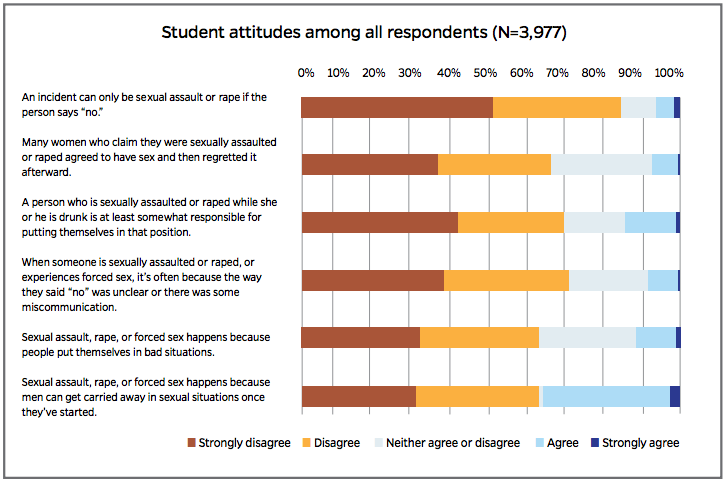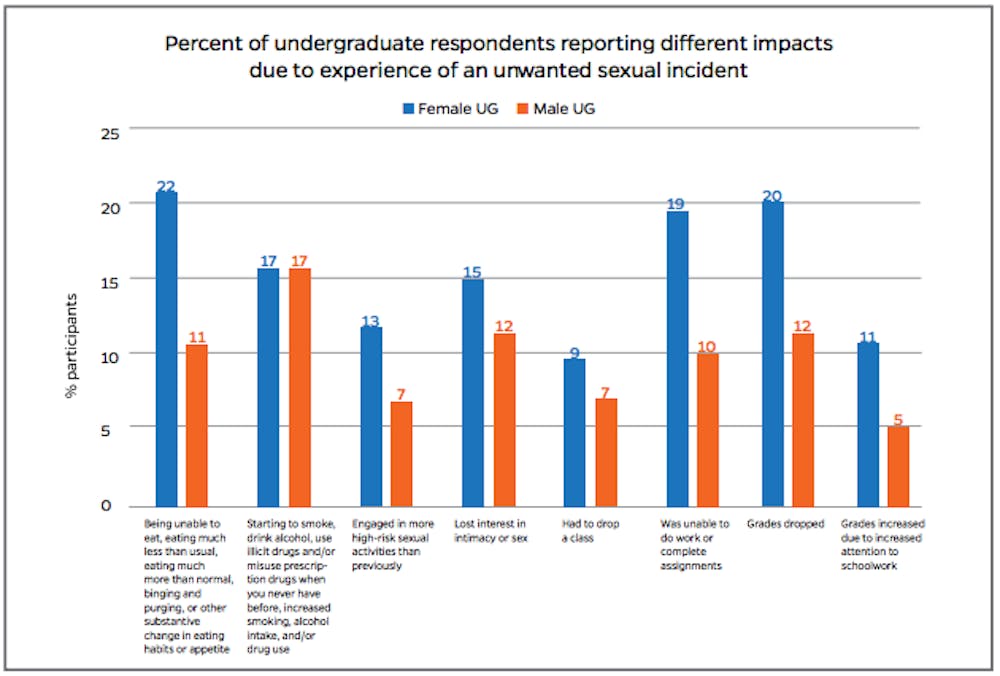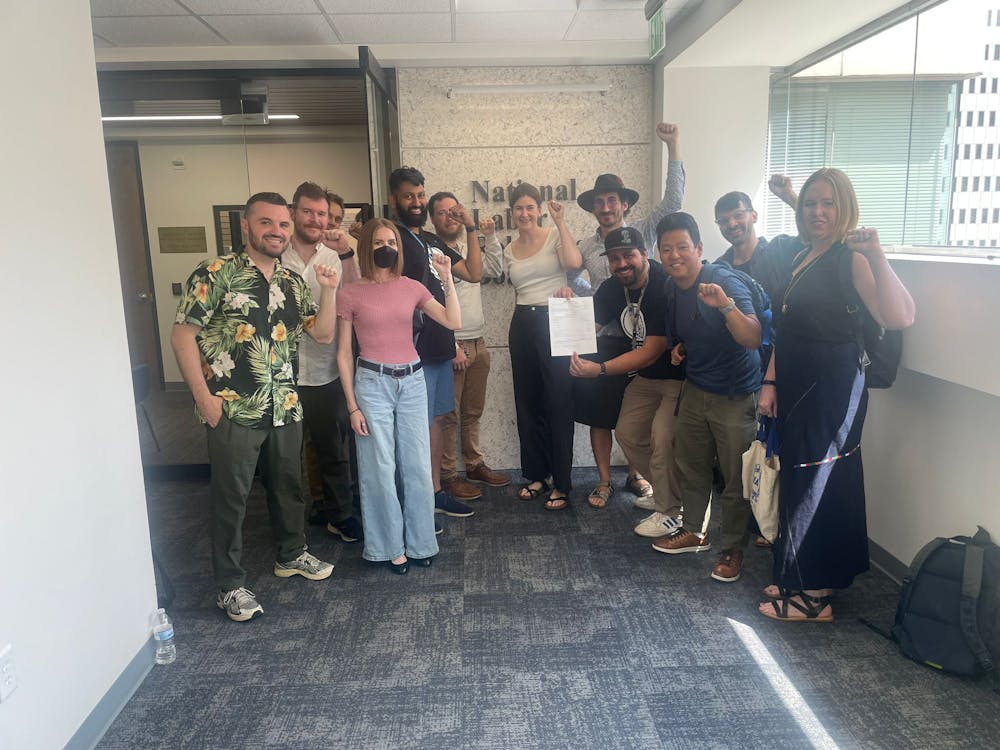The University released a report on Jan. 22 detailing the findings from a University-wide sexual assault survey, titled “It’s On Us Hopkins.”
Provost Robert C. Lieberman and University President Ronald J. Daniels first convened a group to create the survey in the fall of 2014. School of Nursing Professor Jacquelyn Campbell spearheaded efforts to better understand the prevalence and reporting of sexual violence on campus.
Interpreting the Results
“It’s On Us Hopkins” was made available to students across all nine divisions of the University and was based on the 2014 Community Attitudes on Sexual Assault survey conducted by the Massachusetts Institute of Technology (MIT). Data from the Hopkins survey was compared to a survey conducted by the Association of American Universities (AAU). Hopkins is an AAU member, but chose not to participate in their findings.
Out of 12,773 undergraduate and graduate students asked to participate, there was a 31 percent overall response rate. This is slightly lower than that of MIT’s survey (35 percent) and higher than AAU’s 19 percent.
When asked whether the 31 percent response rate was satisfactory for the University, Executive Vice Provost for Academic Affairs Stephen Gange explained that a higher percentage would have been preferable, but that Hopkins still fared better than other universities.
“A low response rate doesn’t necessarily invalidate, in any way, the results of the survey,” he said.
Within that 31 percent response rate, 613 students reported they have experienced “some type of unwanted sexual behavior at JHU,” for an overall rate of 15 percent. This represents nearly one in seven students at the University.
The survey divided unwanted sexual behavior into two categories: unwanted sexual contact and sexual violence. Students were also asked about tactics the perpetrator used to commit unwanted sexual behavior, such as incapacitation through drugs or alcohol, threats or physical harm. It was found that more people experienced unwanted sexual contact over sexual violence, and incapacitation through drugs and alcohol was the most popular way in which perpetrators attacked their victims. Across the board, more female students than male students reported experiencing sexual assault.
“It’s On Us Hopkins” broke unwanted sexual behavior into “described behaviors” and “labeled experiences,” a distinction that the survey explains illustrates an important deficit in the way students are taught to think about their sexual experiences. The survey results indicate a higher reported percentage of labeled experiences than described behaviors. Labeled experiences are more vague than described behaviors, which means that survivors might not consider their experience to be violent, just because they did not experience explicit behaviors that correlate with “violence.” Instead, they place their experience in a broader labeled category. In essence, what happened in an experience can appear skewed to the survivor. This contributes to the idea that students may not realize they have experienced sexual violence because their individual experience does not fall under a particular described, violent behavior.
Michele Decker, an associate professor at the School of Public Health and the director of a women’s health and rights program, had ideas about how the University can help students recognize the difference between labeled experiences and defined behaviors, so they do not misreport their experiences and clearly understand what has happened to them.
“Working on a crisis hotline for many years, the number one call from people was always, ‘I wasn’t raped, but...’ And it’s what’s behind the ‘but,’ and what do we think our definitions of these experiences are versus what the reality is in terms of definitions we might have here on campus,” she said. “I think there’s a big communication piece there, and it’s a wonderful role that’s already begun and will continue, to give people other frames of reference [for the experiences] that may go beyond what they’ve learned over the years.”
Decker also emphasized that teaching the definition of consent is one of the University’s primary focuses. Gange said that he believes the University has done justice to the discrepancy between labeled experiences and described behaviors by allowing respondents report of their experiences in different ways. This, he said, allowed Hopkins to capture the data both in the behavioral sense and how students label what they’ve been through.
Donju Lee, Class of 2015, noted the discrepancy between behaviors and labels in her evaluation of the survey results. As a former member of the Sexual Assault Resource Unit (SARU), Lee described how people can easily mislabel their experiences.
“A lot of the results pointed to the type of unwanted sexual behavior being somewhat normalized,” Lee wrote in an email to The News-Letter. “There’s the discrepancy between incidence labeled behavior and described behavior, where people don’t seem to realize or consider themselves as having experienced ‘sexual harassment,’ but will still say that they’ve experienced behaviors that fall under that term.”

Fear and Transparency
“It’s On Us Hopkins” was conducted anonymously and included explanations as to why students didn’t report their experiences publicly to the University or other outlets. Out of those who reported it, 18 percent “feared being blamed or not believed”, and 16 percent “didn’t think JHU administration would do anything.” This raises the issue of transparency and what actually happens when a student reports a sexual violence experience to the University.
Interim Title IX Coordinator Sara Slaff said Hopkins has the infrastructure in place to provide students with total transparency through the reporting process. She said students should not be afraid the administration won’t take their experience seriously.
“Quite frankly, that statement, based on my experience with the institution, seemed incredibly surprising. Cases are taken extremely seriously. We have three trained investigators and two investigators that are being hired to handle all the cases in the office... [That] would be the summation of my feelings about the institution and the office in this area. I think we take it extremely seriously,” Slaff said. “In my time as Interim Title IX Coordinator, sometimes I think even students are surprised by how quickly we respond and how seriously we take these investigations.”
Despite Slaff’s confidence in the administration, sophomore Lindsey Cohen, a Bystander Intervention Trainer (BIT), believes that students are “absolutely” more likely to report their experiences in an anonymous survey than to the administration.
“It’s On Us Hopkins” highlighted the fact that many sexual violence survivors know their perpetrators — they were not strangers jumping out of the dark. Cohen emphasized this as a reason for students not to go to the administration, regardless of transparency.
“Because so many people know their perpetrator on a personal basis, they know that if the investigation goes all the way through and gets to the end, their perpetrator will be expelled,” Cohen said. “And they still don’t hate their perpetrator. They don’t want to ruin their lives.”
Cohen further described the difference between “violent” sexual behavior — the use of force — and unwanted sexual behavior brought about by the use of alcohol. She said that students who experienced violence would be more likely to bring their case to the University.
“If it’s ‘just’ alcohol, I feel like at that point, even if they don’t blame themselves, they’ll just say it’s not worth it,” Cohen said.
Ultimately, Cohen said she believes the University is still not as transparent as possible when it comes to providing resources for students.
“Even now, someone’s going to have to search to know what to do,” she said.
Sexual Violence and Campus Culture
The University’s survey compares its results to those of other schools across the country and finds that Hopkins’ numbers are comparable to what students have experienced at other institutions. This might speak to a widespread campus culture of date-rape drugs, alcohol, unclear consent and hazy sexual encounters individuals may not remember. There is also the persistent perception among students that universities will not take their claims seriously, a perception substantiated by documentaries such as “The Hunting Ground” and new articles every week, in which sexual violence is swept under the rug to protect a University’s reputation.
Gange, who prepared the “It’s On Us” summary, spoke to the still-developing minds of college students.
“I’m the father of an undergraduate female,” Gange said. “Everyone knows, I think, that one doesn’t immediately become an adult at age 18 and go off to college. And people are still developing and learning to become part of a culture and community.”
Despite the idea that underdeveloped minds in an unsupervised environment can lead to negative situations, Gange emphasized that any occurrence of unwanted sexual behavior is inadmissible.
“The responses of particularly undergraduate women who reported these types of behaviors are not trivial,” he said. “When we’re reaching numbers like we’ve shown in our report, it’s really just completely unacceptable.”
Slaff echoed Gange’s statement.
“Sexual assault at every level and every stage is unacceptable, and the institution now has the data to initiate a course of action,” she said. “But as far as time to solve all the societal problems related to this, it’s a challenge beyond the institution.”
Decker painted a picture of undergraduates on campus and how a new environment might present confusing and unsafe situations.
“We want so much for safety, particularly at those ages, but we do know that people are away from home for the first time... They’re new to negotiating all of this,” she said. “People are getting comfortable trying and doing as they’re becoming mature adults. Unfortunately, that is part of this as well. Something that’s certainly not unique to Hopkins, but something that we’re so concerned about.”
Lee shared her perspective on sexual violence in campus culture and University responses to this issue.
“I think it’s just part of mainstream culture; we like to say we live in a Hopkins bubble but it’s still part of the larger community and it still takes cues from and adopts the values of our culture more broadly,” she wrote.
Close quarters on college campuses can breed a culture of violence and ignorance. While the University advocates for their own transparency measures, Hopkins students have mixed opinions about their administration.
One critique comes from Cohen, who criticized the way the University has responded to previous high-profile sexual violence cases associated with fraternities. In the past few years, both the Pike and SAE fraternities have lost their charters as a consequence of sexual assault cases.
“The administration has definitely cracked down on Greek Life, thinking that’s the issue when it’s really our culture,” she said.
Unlike Cohen, Lee supports the University’s response to sexual assault cases that involve Greek Life.
“The response last [fall] to a rape happening at an off campus (but still Hopkins associated) fraternity house seems like a step in the right direction, where it shows the school’s willingness to follow through and make sure that they provide a safe environment for everyone,” Lee wrote.
Beyond administrative handling of events, some students have a positive outlook on the resources Hopkins offers for sexual violence survivors, including counseling programs and other methods of helping students through difficult situations.
Moving Forward
How does Hopkins move forward after the release of “It’s On Us”? Programs have already been implemented for freshmen to better educate them on how to get consent and what to do in potentially dangerous situations. One such program is Bystander Intervention Training (BIT), which is now mandatory for all members of each freshmen class. It first became a required practice this fall for the Class of 2019.
Cohen, a BIT trainer, thinks mandatory training is a good first step, as do Slaff, Decker and Gange. However, they said, the main focus of potential future campaigns will be an even more thorough evaluation of the data collected.
“We don’t want to, in any way, stick our heads in the sand,” Gange said. “This will spur additional change, and I think it’s quite reasonable to ask, if we were to gather new data, would we see measurable effects, as to students knowing terms, knowing resources and where to get help.”
Gange said there is no definitive plan for moving forward as of right now, but he stressed Hopkins will move forward and increase collaboration between the administration, professionals and students.
Students are also unsure on how to proceed, but students agree unwanted sexual behavior of any kind should not be tolerated. Sophomore Austin Kemper shared his perspective on the percentage of students that have reported experiences with unwanted sexual behavior or violence at Hopkins.
“15 percent is too high,” Kemper wrote in an email to The News-Letter. “Any number over zero is too high.”
Resources and information on sexual violence can be found at the University's Sexual Assault Response and Prevention Website, sexualassault.jhu.edu.





